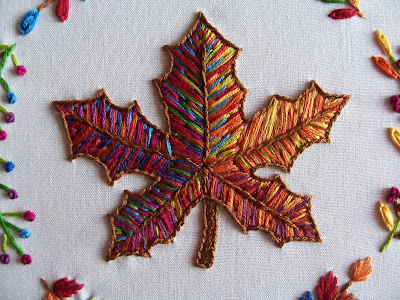Vintage Pumpkin
Test Piece for Pilot FriXion Pen Transfer Method
Test Piece for Pilot FriXion Pen Transfer Method
Following my success with using a blue Washable Marker to transfer an embroidery pattern, I decided to work up a small tester with another very popular transfer method I've never tried: The Pilot FriXion Pen!
The FriXion pens are not meant for use on fabric. They are ink pens that come with an eraser on the bottom end (and wow, do I ever wish these had been out when I was writing exams in school!). They are very popular among quilters but are controversial in the embroidery community. Mary Corbet of Needle N' Thread very succinctly sums up her reasons for not using these pens to transfer embroidery patterns.
Namely, the ink does not really disappear. It can leave "ghost lines" that usually re-emerge if the embroidery gets cold, which is something to keep in mind if you are sending your work through the mail. So this is not a flexible transfer method like the Washable Marker - you have to intend to cover most of your lines.
Last year, a good friend sent me a black Pilot FriXion pen to try. They come in several different types and sizes. Mine is the extra fine 0.7 ballpoint, and I love the way it writes! The line is clear but thin, and the ballpoint glides over the fabric. Like the Washable Pen, you need to be able to see through your fabric to trace your transfer.
Most articles on using FriXion pen for embroidery transfers say that you need to iron the ink out. Since I usually iron embroidery from the back (placing the front on a thick fluffy towel so the stitches aren't squashed), I was a little nervous about ironing on the front. Then, a few weeks ago on Instagram, a stitcher said she used a hair dryer. Genius!
So that's what I tried, and it worked a treat! I'm afraid there are no good Before-and-After shots, because I did stick very close to the pattern. A few little bits around the curly vines were all I had to go by, but one blast of heat and they vanished. Obviously, this is something I will have to experiment with a bit more, but I am optimistic that these pens would be a good method for quick, casual patterns.
I really like that the line is easily visible but that you do not need to wash the finished embroidery. And although the FriXion pens do not give you the flexibility of Washable Markers, they do give you a tiny bit of wiggle room versus a lead pencil (my usual method). You need to be sure of your design and stick close to the drawn lines but if you do have an "oops!" moment, you can blast it away with heat.
I am looking for a transfer method that gives fine, non-smudging, easily visible lines that are thin enough to be covered by outline stitches, and this pen seems fits that bill!
Project Details
◾ Vintage Pumpkin from online freebie, unfortunately no longer available
◾ 4" wooden embroidery hoop
◾ 100% quilting cotton, Ecru
◾ DMC Floss:
Pumpkin: 900 (Dark Burnt Orange), 6 strands, Stem Stitch
Leaves: 986 (Very Dark Forest Green), 4 strands, Split Stitch Outline, and Backstitched Veins
Curly Vines: 988 (Medium Forest Green), 2 strands, Stem Stitch
All in all, I'm very happy with how my little Pumpkin turned out! I'm having fun right now stitching up these little transfer method testers, and the next is a pretty little bird that will try out the Washable Marker on Lazy Daisy stitches 🌼
Have you used a Pilot FriXion pen to write on fabric? How did you find it?























